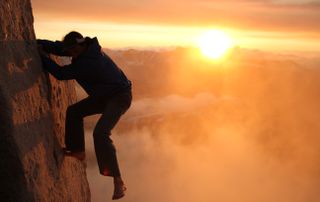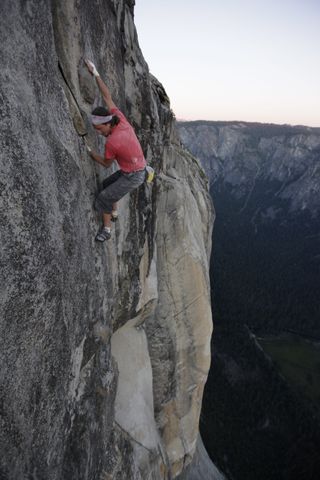
3,000 Feet of Air Below Your Feet: A Q&A With The Man Who Can Fly

Dean Potter, the star of the National Geographic Channel's new show, "The Man Who Can Fly," is not only a world-famous wingsuit pilot, but he's one of the world's most renowned rock climbers.
Potter was the first person to free solo climb the main face of Yosemite National Park's El Capitan. That's 3,000 feet (900 meters) straight up. Without a rope.

In his one-hour special currently airing on the National Geographic Channel, Potter along with his small inner circle attempt the first team free climb of western Canada's Mount Bute ... so Potter can then BASE jump off the top. BASE jumpers leap off structures, including buildings, antennas, bridge spans and cliffs, and glide down using parachutes. [See more photos of Potter in action here]
OurAmazingPlanet caught up with Potter over the phone to get the scoop on his first flight, how being a climber and flier is a terrifying combination, and what keeps him hooked on heights.
OurAmazingPlanet: Can you tell us what got you into wingsuit jumping?
Dean Potter: I think everybody has a dream of flying at least once in their life. For me, it's been over and over a recurring dream. It's mostly that. That desire to be as free as the birds, to be unhindered. I started off as — and am still — a free solo climber. So being in the air is a huge fear of mine. So there's a combination of going toward my fear as well as being fascinated with the air.
OAP: Do you remember your first jump?
Sign up for the Live Science daily newsletter now
Get the world’s most fascinating discoveries delivered straight to your inbox.
DP: Absolutely. It was out of an airplane in Colorado, and I was taking my advance freefall course, doing my level 1 jump. My heart was racing. Like I said, I have a lot of fear with falling, so I panicked. Then I let go of the door of the airplane and kind of panicked the entire way. But after a few jumps I grew more calm, realized what was going on, and I think that was the key. The more calm I got, the more relaxed I was, the more I was able to feel the air and actually recognize it as an element and something I can move with.
OAP: When you're at such great heights, you have a view of the Earth that most people will never see. Are you able to enjoy the view?
DP:I absolutely am able to take in the beauty, and that's what it's all about. It's not like an adrenaline sport. It's just a very calm feeling. My senses peak and I take in way more than in normal reality.
OAP: A wingsuit pilot recently crashed during an accident that was blamed on a gust of wind. How much do you study and prepare for the weather?
DP: Well, I'm a pretty wild guy and I live pretty close to nature — I've often lived in caves or on the edge of cliffs or in forests — so it's just second nature for me to tap into the movings of the weather and the world. I have a strong feeling for it, and I think us as humans perceive all of that — the pressure change and the moon and the wind and whether a storm is moving in on us — if we just are close enough to nature. But more and more people seem to be separating from nature. I'm trying to go in a different direction. I'm getting closer and closer.

OAP: You trained on El Capitan in Yosemite. Ropeless. Can you even put into words what it was like to be up there, free and without ropes?
DP: Well I wouldn't really call it training. It was as real as it gets to be up there on El Cap. It was the first time anybody had ever been up on El Cap, on the main face, free solo. I struggled a lot up there with the 2,500 or 3,000 feet [762 to 914 meters] of air below my feet and the knowledge that if I fell I would freefall a good 20 seconds before impact. It's kind of strange to be a free soloist when you know so much about flying, because I'm playing two opposite games, or practicing two polar opposite arts. One is the art of not falling. The other one is flying. With both those things spinning in my mind, there's a lot to process and it's pretty mind-boggling.
OAP: Once you climbed to the top of El Cap, you weren't able to BASE jump because it is illegal in Yosemite. How do you feel about that?
DP: It's a thing I struggle with a lot, that in my hometown BASE jumping is illegal, and that Yosemite is really one of the safest places to learn to BASE jump off the steepest, tallest walls and the best climate, pretty much worldwide. I think it's something that the public and our country should be proud of that we can experiment with human flight. It's one of the most fundamental desires of man, of being free and flying unhindered, and it really seems to go a lot with our founding fathers' principles of freedom. But for some reason, BASE jumping is misunderstood and our government forbids it and makes it illegal in most every place in the country. So I'm kind of a criminal here in the United States for pursuing the dream of flight, but everywhere else I go, every other country, I'm kind of looked up to, or fascinated with for the flying that I do. It's kind of strange to have to leave the land of the free to spread my wings and really be free.
OAP: In your National Geographic show you attempt to climb and fly from Mount Bute in western Canada. What drew you there? It's not exactly easy to get to.
DP: It was potentially going to be one of the biggest walls I've climbed as well as maybe the biggest thing I've jumped off of. The emptiness and remoteness of being out there is something that I long for. Even though I am in the public's eye a lot, that's kind of in a secondary way, because what I'm always trying to do is just be closer to nature and to be more alone or just with a small group of friends. So it was really intriguing for me to go up Mount Bute with just a few friends and try to do the first free climb of it as a team. A lot of people confuse free climbing with free solo. Free climbing is when we use ropes, but we only make upward progress with our bodies. And so we climbed the first free ascent of Mount Bute as a team, and then figured out a way for me to fly off the wall.
OAP: When you're standing on a cliff like at Mount Bute and are about to fly off, what's going through your mind?
DP: The moment before I jump is filled with anxiety and what-ifs. But then as soon as I enter the air, I'm filled with this calmness and that's the main attraction to it. That's why I do these death-consequence pursuits or arts. It's not cause I'm an adrenaline junkie, or Evel Knievel — I kind of cringe at both of those words — it's because by doing these things our perceptions become heightened and we sense and feel emotions and see and hear and touch and feel more deeply than ever before. That's the real hook for me.

OAP: What's a successful flight to you?
DP: Any flight or any experience in life where I have fun — and I don't get injured. I don't have a lot of pressure on myself to be successful. I'm more of an artist. I just try to make myself more a part of the most beautiful painting as possible. And enjoy it.
OAP: Since our site is OurAmazingPlanet, what's your favorite "amazing" thing about planet Earth?
DP: I just love any place that I can sit in the sun and feel the warmth of the sun's rays, and feel the connection to the planet, really tapping into how small I am and really how insignificant I am in comparison to the universe.
You can follow OurAmazingPlanet staff writer Brett Israel on Twitter: @btisrael. Follow OurAmazingPlanet for the latest in Earth science and exploration news on Twitter @OAPlanet and on Facebook.
